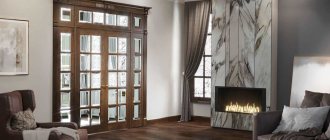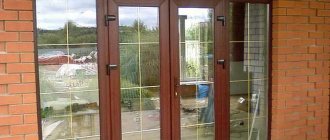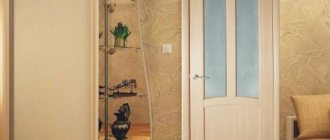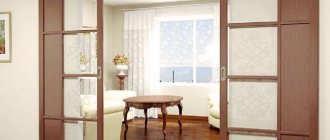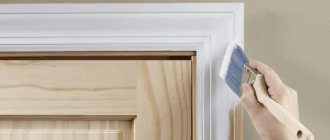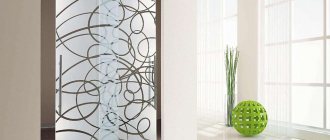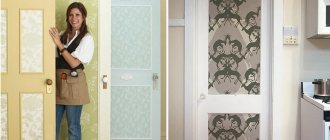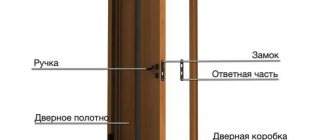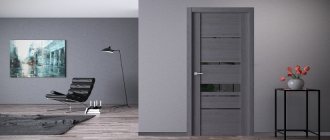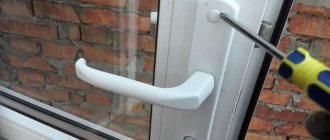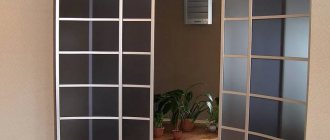SHARE ON SOCIAL NETWORKS
FacebookTwitterOkGoogle+PinterestVk
Eco-veneer interior doors are made from a cost-effective material with a synthetic coating, which looks very similar to a cut of natural wood - veneer. Before purchasing, many are interested in what such products are, what pros and cons they have. Clients also want to learn more about the types, sizes, and color palette of the canvas. The information in the article will help you choose a product, learn about the properties of the material and options for caring for it.
Eco-veneer is a modern material that externally imitates the structure of wood.
What is eco-veneer?
So, what is eco-veneer made from ? – There are many versions about this on the Internet. The most common is wood fibers or sawdust in resin or polymer, all of this is pressed and rolled into a film. Probably material with such a composition exists in principle, but is not used in Russia. In our country, eco-veneer is considered to be polypropylene film with wood-like decor.
But in fact, under the “eco-veneer” label, we sell doors with three types of coatings:
- Cheap finishing film: These are the same laminated paper doors with a very low cost, usually drawer-sided in design and very similar to real eco-veneer ones. They are passed off as real only by irresponsible manufacturers and sellers;
Polypropylene films are durable, thick, safe for health, like a polypropylene medical container;
PVC films – this also happens. To diversify the assortment and offer the consumer completely new “wood-look” doors, there is no need to buy new equipment - nothing needs to be changed except the name. And what’s interesting is that there seems to be nothing to blame the manufacturer for, since there are no fundamental differences to be found in the properties of PP and PVC. Polymers are in a sense interchangeable, with the exception of some details, but more on those later.
Why did it even occur to sellers to pass off doors with cheap finishing films as eco-veneered? In short: polypropylene films and cheap finishing films can be applied to doors using the same equipment. Those. a manufacturer, without changing machines, simply by selecting other modes, can enter a higher segment where PVC dominated. Tsar doors did particularly well, due to their more modern design and lack of edges. Despite the fact that polypropylene film is slightly more expensive than PVC, in general, the costs are low, and the products can be sold at 1.5 - 2 times more expensive. Over time, side doors coated with eco-veneer became so popular that strong competition began among these models and began to attract prices. This is where very inexpensive side doors appeared on the market, like those with eco-veneer, actually with a cheap finishing film.
Eco-veneer is in fashion. Why, doors with such a coating are simply wildly popular. The leader in the middle price segment, which PVC was previously considered to be, had to make room. The most interesting thing is that people don’t really want to understand the similarities and differences of materials, the cause-and-effect relationships, which, by the way, are the same here:
- The reason is a bright advertisement of a new product with a hypnotizing prefix “eco”, which acts on the subconscious like a pipe on a boa constrictor;
The consequence is high demand among consumers with average incomes, who are the majority.
How it works? One of the options. You came to the store and still don’t know about the existence of doors coated with eco-veneer. You need a door that costs about 3 - 5 thousand rubles. The consultant takes you to the department with the cheapest laminated doors. You observe their frankly cheap appearance, and the seller says that they are short-lived, are afraid of moisture, etc. Accordingly, after this, move on to PVC structures, the consultant talks about their water resistance, quality, beauty, and ease of maintenance. If he sees that the buyer has doubts about the choice (he doesn’t like the rustic design, the surface doesn’t look very similar to natural veneer), all that remains is to put the squeeze on him. This is easy to do, because on the contrary, they are safe, very beautiful doors made from natural wood. An environmentally friendly product without chlorine, it costs little, is durable, and has a modern drawstring design. None of the guests can believe that this is also an ordinary film, albeit polypropylene, because the coating is so similar to natural veneer. It's hard not to give in to temptation, isn't it?
Is PVC film really unsafe? It's time to put an end to the legend of PVC toxicity once and for all. To do this, you do not need to conduct special experiments - just remember the school course in inorganic chemistry. Chlorine gas is known to be poisonous. It is part of PVC, which is determined by its name. However, in the polymer it is used in a bound form and is vinyl chloride. There are a lot of such safe chlorides in our everyday life. For example, sodium chloride, or regular table salt. If chlorine were used in the above-mentioned formulations in its pure form, it would look like the popular “Belizna” cleaner: there is about 95% chlorine, it is incredibly toxic and emits a terrible odor.
Therefore, the environmental friendliness of PP compared to PVC is a myth. Another thing is the compositions with which they are coated, or rather, with the help of which the decor is made on the surface of both films. So, these dyes, fixatives, etc. may contain resins based on formaldehyde, methanol - components harmful to humans and nature. Remember how new linoleum, a Chinese inflatable pool or rubber Crocs phonate when the item is new or the surface heats up under the influence of sunlight. The smell indicates the use of a dangerous, low quality additive. It is better to get rid of such a product, including doors.
At the same time, the quality of the decor determines how PVC and polypropylene (eco-veneer) look. How similar are they to natural wood or other natural materials? It is the quality of the decor that explains why one film conveys all the nuances of a wooden surface so well, while the other looks cheap. Polypropylene is a relatively new facing material; it is made using modern equipment and its decor is often better than that of inexpensive PVC film. This is precisely what explains the emergence of such a powerful, from a marketing point of view, association with natural veneer.
Conclusion: eco-veneer is polypropylene. It is slightly more expensive than PVC and requires different equipment to apply to the workpiece. Both materials are waterproof, produced with matte and glossy textures, the degree of resemblance to natural wood depends on the quality of the decor.
Types of installation and necessary accessories
There are at least 5 common options for interior doors, taking into account the type of opening. Are you asking why little is known about them? Yes, because the swing structure is the one that hangs on hinges and opens towards or away from itself - it is familiar to our people. Many do not even consider other methods of opening, including because they believe that everything that does not swing open is newfangled things of dubious quality. Alas, it is difficult to move our man - but we will try.
To begin with, keep in mind the main thing - any design was created for a reason. Apparently, at a certain period of life, people began to understand that the swing nature of the opening is not optimal in all situations, which means that each model has its own characteristic area of use. And it’s not so much a matter of “like it or not,” but the ability of each design to better implement the intended functionality in a particular position.
So, swing doors are the most common category. Let's start with them. We invite you to talk about what installation methods, additions, and fittings are most likely used with interior doors made of eco-veneer.
You can’t forbid living comfortably... why don’t people want to give up the good old swing doors?
It so happens that interior doors will be more convenient to use if they open into the room - “from yourself”. But from which side to hang the hinges - it depends on the location of adjacent walls, on the presence of nearby windows, other doors, etc. Having chosen the optimal location, we begin to study the types of hinges, handles and additional elements.
Door hinges
Let's consider the existing options for door hinges from the standpoint of reliability and price.
The cheapest hinges are not embedded, but simply screwed to the surface. The so-called “butterflies” may be suitable for light and cheap doors made of eco-veneer, but they are not reliable, because due to the installation features they do not provide stability and rigidity to the door leaf. Perhaps the only ones who benefit when choosing such hinges are the installers: they are hung on self-tapping screws and spend no more than half an hour on the entire operation.
At the second level in terms of cost are overhead (card) loops. Made from brass and steel. One half is attached to the box, and the second - to the canvas. A completely acceptable option. Its disadvantage is that the hinges are tightly attached, and if you need to remove the door, you have to unscrew the screws, which is not always convenient.
The third option is detachable hinges. They are a two-piece set. Just like card ones, they are attached to the box and to the canvas, which, if necessary, can be easily removed and hung back.
Doors made of eco-veneer are lightweight. They do not require installing a third additional loop, as is the case with solid wood structures.
The fourth option is hidden hinges and, accordingly, hidden door installation. When you see such a model, you get the impression that the canvas is a continuation of the wall. Neither the hinges nor the box are visible from the outside, and there are no platbands at all. Hidden hinges are rarely used in conjunction with an eco-veneer door. Such mechanisms cost about 1200 rubles. Increasing the price of a model by 30-50% contradicts the task itself, which is to buy an inexpensive door with the appearance of an elite product.
Installation secrets, or why identical doors look different after installation
It all depends on the type of installation and the type of moldings. Let's look at 4 common methods:
- The door leaf and platbands are in the same plane;
- Application of aluminum box;
- Arrangement of semicircular or flat platbands;
- Use of telescopic moldings.
Installing the canvas and platbands on the same level is a fashionable trend, thanks to which entrance groups lose volume, become more refined and light. A door made in the same color as the wall, which is its continuation, looks especially impressive. To make the result appear even brighter, relief is made on the walls in the form of straight, wavy lines, ornaments that do not end at the junction with the door, but, on the contrary, continue, and serve as an additional means of camouflage for it.
Aluminum box is another fashion trend. And here they use 2 design techniques:
- When the canvas is an independent object in the interior;
- The door is part of the wall.
Smooth, durable aluminum gives the model a modern look, and also takes care of the integrity of the most vulnerable part of the door structure. But even in this case, no matter how attractive the idea may be, it is not advisable to use it in the context of installing an eco-veneer door. Why? – That’s right, because of the price, and it will jump 4 times, no less.
Which form of platbands to choose depends on the style:
- In the shape of a semicircle: a spherical frame is obtained. Such models, as well as drop-shaped, corrugated, profiled, with capitals, in the Greek style, are suitable for classics. The top and two vertical semicircular crossbars are joined at an angle of 450;
- Flat trims, as well as joining at right angles - for a modern design.
The platbands are made from the same MDF from which the canvas is made.
Sliding structures
There are several types of sliding structures. Some are simple, common and inexpensive, which means they are most suitable for doors in the low price segment. Others are complex, with expensive fittings and hidden installation. This category includes Invisible systems , rotary doors, and books. These are practically not used when installing eco-veneer doors - as a rule, they accompany interior doors made of solid wood or natural veneer, which belong to the expensive segment, because they themselves cost a lot and contribute to the rise in price of the model.
In general, sliding doors, no matter how beautiful they are, are designed to make up for the shortcomings of swing doors. We will not touch on the controversial issue of saving square meters, especially since in this case we are talking, rather, about a few centimeters. But the fact that the sliding system, when open, will not block access to the adjacent room, will not slam shut due to a draft, and will not injure a child’s hand when he decides to play with the door - it’s hard to argue with this.
They have their negative sides, for example, it is impossible to simply push the canvas when your hands are busy. They do not have a seal to protect against external noise. Still, experts believe that the main disadvantage of sliding doors is subjective. Their popularity is low because people are not used to such an opening system. Yes, and the roller mechanism, consisting of rollers, two guides and brackets for attaching them to the wall, does not always provide a 100% guarantee of flawless operation. Although, in aesthetic terms, a room decorated with a wide sliding door made of eco-veneer with an excellent imitation of mahogany or oak will undoubtedly only benefit.
How to choose high-quality doors coated with eco-veneer?
If you read the previous chapter, you are probably puzzled how to distinguish one coating from another, because in the store all the doors seem the same?
The surest remedy is to study the upper end part of the canvas. It remains invisible, so it is not covered with decorative films. Everything is visible here - frame materials, finishing, as well as their thickness. What is in front of you, laminate or polypropylene - try to lightly pull the edge of the film. Laminate flooring is made from cellulose. It is not plastic, so it will tear like paper, unlike eco-veneer, which stretches.
If you are convinced that the sample is indeed film and not paper, what next? How to determine quality? It's simple, firstly, the thicker, the better and stronger. Secondly, pay attention to the decor. It should be clear and not a copy of a copy. You should like it, its relief, shades, everything should be similar to the natural original.
Now about construction materials. Inexpensive ones go into production:
- Solid pine - to strengthen the load-bearing parts of the door leaf;
LVL timber, in our opinion laminated plywood, is used for the same thing as pine timber, only in more expensive models. It is stronger than pine timber and less responsive to changes in humidity;
MDF panels are the most popular material in the door industry. All doors that are not 100% solid wood contain MDF in their construction. It is durable, cheap, and does not change its geometry depending on external conditions. Therefore, it is an ideal base (substrate) for an external decorative layer, no matter what: all kinds of films, natural veneer, enamel. If you apply the coating directly to solid pine, nothing good will come of it - the veneer and enamel will crack, the film will peel off. Well, wrapping doors made of noble solid wood (resistant to everything) with cheap film or something else is not profitable, not to say absurd.
High-quality doors should be durable and have good sound insulation. If the manufacturer saved money, then there are many cavities inside the elements of the canvas that can be filled with corrugated cardboard. The more of these cavities, the lighter the door. Also, it is simply necessary that the door is assembled well. From here:
- By any means, try to estimate the mass of the door leaf. The heavier the better.
The drawstrings (prefabricated) need to be lifted at one corner to see if there is any sagging. For the same purpose, you can measure the diagonals; for normally assembled ones they are the same.
Tap the door inserts to see if they are hollow. Click on them to understand how they are secured.
Inspect all joints and fastening points. Everything should be neat, without gaps, protruding materials, etc.
If possible, we again recommend looking at the top or bottom end of the door leaf, all the materials are visible there.
Inspect how the moldings are made. The thickness of the frame indirectly indicates the weight of the door leaf; the manufacturer usually does not make a safety margin, everything is calculated back to back. Durable frames for heavy doors are a sandwich of LVL timber and MDF. Examine how the coating is applied and what it is - it can be seen very clearly on the platbands.
Color solutions for interior doors: options
Eco-veneer or veneer: which is better? Each buyer decides this issue independently. Having decided on the option, he begins to choose a color. The coating imitates natural wood as accurately as possible. The canvases accept the following types of wood shades:
- beech;
- wenge eco-veneer doors;
- larches;
- light oak;
- ash;
- Italian walnut;
- mahogany.
Doors can be natural wood shades or bright and custom
Non-standard color solutions are considered:
- smoky gray;
- pearl vanilla;
- white;
- cappuccino;
- other unusual tones.
You can buy eco-veneer film of any color at an affordable price. A wide range of shades helps create a unique image of the room. Depending on the chosen shade, the room takes on a modern or classic look.
How to install them
High-quality installation is 50% of success, so the main thing in installation is to find a professional technician. There are no special installation instructions for doors made of eco-veneer. The same rules apply that apply when installing panel, panel and other models.
Before installation, please pay attention to the following details:
- Where the door leads: models with transparent glass are not suitable for the bathtub and toilet. On the contrary, if the door from the hallway opens into the living area, let it have a glass insert to let more natural light into the windowless interior;
In which direction the door will open: this point must be indicated in the application or clarified when choosing a product in the store. Universal models with double-sided installation are also found, but less frequently;
Moisture resistance of the door - this recommendation is not relevant for a product made of eco-veneer. Polypropylene protects well from moisture.
If you have to choose a door for a non-standard opening, you can:
- Buy a product of the appropriate size: it will be more expensive, but it will solve the problem, albeit one-time, since during the next repair it will arise again;
Install a blind transom at the top or side;
Use a more radical solution and adjust the opening to the door, thereby eliminating the problem once and for all;
Install a door with two leaves: if the width is more than 900 mm, do not overload the frame, hinges, or adjacent walls. It is better to distribute the weight over 2 sashes to avoid sagging;
Install a sliding door - single or double leaf.
Consumer opinion about Volkhovets models
The company supplying the market with doors of this brand was founded in Russia in 1995. Currently, it has 2 production sites - one in Maykop and one in Veliky Novgorod. For the production of interior doors, the company uses high-quality Italian eco-veneer.
Currently, the company supplies the market with interior structures of a wide variety of designs. If desired, consumers have the opportunity to purchase a model of this brand from “Snow-White Linden” to dark “Oak”. That is, you can choose such an interior design for any interior.
The advantages of doors from this manufacturer are, first of all, a very attractive design. In the interior, doors from Volkhovets look more attractive than designs from many other companies. Some of the disadvantages of models of this brand include a fairly thin outer coating. Aggressive household chemicals (hair dye, peroxide, etc.) can, unfortunately, corrode it. Apartment owners who decide to purchase doors from this manufacturer should keep this in mind.
Pros and cons of coverage
The low price of eco-veneer is its main strong point. In principle, this material would be useless: well, why do we need synthetics if we have a natural product. The point is the low price, which made it possible to significantly reduce the cost of beautiful, high-quality doors and make them accessible to large masses of users.
Another advantage of eco-veneer is its heat resistance. In this respect, it is superior to its eternal competitor - PVC. Polypropylene can withstand heating up to 140 degrees without losing the specified physical properties. The surface of the film does not deform under the influence of water vapor, which means it is “welcome” for small kitchens with a stove located close to the entrance, and for bathrooms.
Also eco-veneer:
- Environmentally friendly: does not contain toxic compounds - keep this in mind when choosing a door for a children's room;
Does not react to ultraviolet light: which door to place on the sunny side is a resolved question;
Practical - stains, dirt, dust can be easily removed with a damp cloth. The products are not absorbed into the synthetic base, but the varnish coating helps it remain invulnerable;
Does not fade: wood fibers are first dyed and then added to a polypropylene and adhesive base. Body dyeing imparts color stability to the finish. The door will remain juicy, fresh from the inside and outside. Modern coloring technology makes it possible to obtain shades that perfectly match the color of real wood (analogue). Variation in shades and differences in the arrangement of the pattern, which are always found in natural veneer from different batches, are excluded here. If you want to install 5-6 absolutely identical doors in one room, then choose eco-veneer.
The positive qualities of eco-veneer more than compensate for its disadvantages:
- Does not withstand low temperatures. At -50C the film becomes brittle, and at -100-150 it cracks and becomes unusable. This means that such a door should not be installed in an unheated vestibule in regions with harsh winters;
Light weight: a relative disadvantage. On the one hand, there is no strong pressure on the hinges and the box. On the other hand, strength and status are lost, so eco-veneer models are only an economy class product, nothing more.
Another drawback concerns doors with hollow MDF board. They are a poor barrier to sound. If you need a door with good sound insulation, it is better to look in another section.
Eco-veneer based on cellulose
Laminate or finishing film - textured paper with a pattern and wood color applied to it, applied to MDF (hardboard). 3D paper is impregnated with special natural melamine resins, which increase its density and protect the coating from mechanical damage and moisture. The material is simply applied and does not require the use of expensive technologies and adhesives. Of all the varieties of eco-veneer, finishing film is the most inexpensive coating. It is mainly used to cover doors in the economy segment, frame structures with honeycomb filling. Such doors are called laminated, they are: plain, 3D with wood texture.
Characteristics of doors covered with finishing film
Advantages:
- Relative cheapness;
- Large selection of various textures and shades;
- The coating is not exposed to ultraviolet radiation and does not fade;
- Safe for health.
- Flaws:
- Of all the coatings, laminate has the worst wear resistance;
- The coating does not protect the canvas from moisture;
- Small thickness.
Suitable or not for the bathroom
Yes, eco-veneer doors are prime candidates for installation in rooms with high humidity. We have already talked above about the property of polypropylene to retain 100% moisture, even when it becomes water vapor. Eco-veneer is not afraid of humidity, high temperatures, or both combined, as well as regimes that change with great frequency. Remember about the edgeless production method and remember - water will not leak through the side ends.
Important! Before installing the door, varnish the top and bottom ends. They usually remain untreated and will become conductors of moisture into the inner layers.
Just keep in mind that condensation on the canvas and the box is not dangerous for them specifically, but not for the wallpaper on the adjacent wall. If the room has poor ventilation, black mold on the walls and ceiling will not take long to appear. This also includes fogged mirrors in the hallway, dampness that can affect the non-moisture resistant finish.
Eco-veneer doors from the manufacturer: manufacturing features
Production is carried out using special presses. The basis consists of waste obtained as a result of wood processing: shavings and sawdust. The latter, thanks to the latest technologies, are mixed with synthetic resins.
To produce eco-veneer doors, special presses are required
The phased type of pressing leads to high reliability and stability of the material. Wood fibers are impregnated with special coloring compounds. As a result, sheet material is obtained and produced in rolls. The sheets are cut and applied to all parts of future doors (MDF and drawers).
Only after wrapping each outer part of the canvas with eco-veneer do all the details come together. The listed production technology eliminates the possibility of material peeling, increases its service life, and ensures the safety of the external data of the product.
The structures are classified under the CPL brand, which indicates multi-layered fabrics. White eco-veneer doors (or any other color) consist of the following parts:
- frame made of laminated veneer lumber, which includes natural coniferous wood;
- built-in elements, lintels - standing ones for doors (tsars);
- MDF boards responsible for forming the surface of the door leaf.
The main components of eco-veneer are wood shavings and sawdust
Eco-veneer is attached to wood sheets.
What equipment is used to make doors made of white eco-veneer?
Why is white material preferred? This is a classic color and is suitable for almost any interior design. High-quality assembly of an eco-veneer interior door from the manufacturer is facilitated by the presence of specialized equipment:
- A milling machine helps produce the main part of the product. At this stage, connecting elements are formed: tenons, grooves.
- A special press glues the door frame together. The device is also indispensable for attaching overhead components of the fabric.
- The circular saw allows you to lay the format and cut the timber.
- For small operations and finishing, carpentry tools are required: jigsaws, grinders, clamps, staplers.
Making doors requires a milling machine, press, saw and carpentry tools
Important! In terms of durability, eco-veneer is not inferior to natural wood.
How to care for them
The rules of care are simple, but first we won’t talk about them, but about the prevention of defects. When purchasing a door, carefully inspect the door leaf and moldings from all sides. The smallest chip cannot turn into a serious problem - we don’t take such a door, even if we really like it and the seller offers a discount.
An animal in the house is also a warning factor. Yes, eco-veneer is dense and durable, but not so strong as to repel the pressure of a huge dog’s claws.
If the door was purchased without fittings for self-assembly, elements that will be damaged during the installation process (attachment points for hinges, locks, handles, as well as the top and bottom ends) are treated with varnish. And some care tips:
- Cleaning is done with a regular cotton napkin soaked in water;
We remove stains, heavy dirt, and kitchen soot using special detergents. Eco-veneer does not react to such compositions. Aggressive chemistry does not change the color of the surface - incl. solvents;
Do not remove stubborn dirt with abrasives. Solid particles in the powder on the sandpaper, especially steel wool, will leave scratches on the surface. You won't be able to delete them;
To clean glass, we use special glass cleaners or folk remedies - vinegar, ammonia.
Video description
About the review of interior doors made of eco-veneer in the following video:
Kinds
Based on their appearance, eco-veneer doors can be divided into two groups. The first group includes structures with a smooth (solid) canvas, that is, without any inserts made of other materials (glass, metal). However, the blank canvas may have panels and decorative inserts made of the same material.
A smooth door leaf is appropriate in the following cases:
- If you want to focus on the texture of the wood, and choose a spectacular, eye-catching coating, for example, status stained oak or exotic: wenge, gonzalo, mahogany.
Dark shade for a respectable interior Source dvernoyexpert.by
What is better eco-veneer or PVC
Having read a lot of speculations and theories about the harmfulness of PVC, about the superiority of eco-veneer, and vice versa, their promotional nature catches the eye. As usual, every manufacturer and seller praises its product, slightly belittling the merits of its competitor. We do not pursue such a goal and we are absolutely clear that there is no difference between eco-veneer and PVC that is worth shouting about.
Judge for yourself:
- Both are polymers synthesized from different raw materials;
Both are water resistant;
Look at the doors in this and that shopping salon - everywhere there is a variety of designs, decors, textures and colors;
Eco-veneer and PVC doors have approximately the same price;
The model range is created by the same designs - panel, panel, drawer, molded;
The style is mostly modern, although there are both classic and retro.
We previously mentioned the disadvantages of eco-veneer. PVC also has them:
- Polyvinyl chloride is more sensitive to high temperatures. If the sun constantly shines on the door, or there is no air conditioning in the room, the film may emit a distinct chemical odor. If installation is to be done in such a room, give preference to eco-veneer;
PVC, polypropylene are still films. Such products will not be able to satisfy the refined taste of true aesthetes, since the tension and clearly visible synthetic component bring a cheap image to the interior. The natural solid material under the enamel is just right here.
Yes, polyvinyl chloride is cheaper than polypropylene, but this difference is not visible in the cost of the final product. Wrapping the canvases in eco-veneer is done using inexpensive high-temperature adhesives. In the same unit of time it is possible to envelop more products than in the same period on machines for the production of PVC doors.
And one more thing - to be completely fair, it is necessary to compare prices and quality for different types of coatings. For example, matte and glossy films.
The quality of matte polypropylene and PVC is not much different. The choice in favor of the first or second is a personal matter for the manufacturer. Another thing is glossy doors. It is easier to gloss eco-veneer than thermoplastic PVC with its textured surface, which looks like an orange peel. There is no way to get rid of it, which means there is only one way out - if you want to replenish the range of doors with canvases with a glossy texture, you will have to switch to polypropylene, which, compared to PVC:
- It has a high degree of gloss;
Does not warp if low quality substrate is used;
Does not become embossed when exposed to high temperatures;
Does not crack;
It is quite elastic (there is no need to make an edge from a different material or select colors);
Stable during production and further during operation.
Eco-veneer made from natural wood fibers
Eco-veneer - made using a special hot pressing technology, from natural wood fibers with the addition of a binder to obtain a strong, uniform layer. This method gives the coating special strength and a beautiful texture of natural veneer. This is an environmentally friendly and healthy coating that is widely used in the production of doors, furniture and various finishing materials. Recently, with the introduction of innovative vacuum technologies, the quality of application of finishing coatings has increased, as a result of which the use of eco-veneer in construction and everyday life has expanded even more.
Characteristics of eco-veneer doors
Advantages:
- Durable coating with increased wear resistance;
- Retains the original appearance, color and texture of wood without changes for a long time;
- Moisture-resistant material, not afraid of high humidity and contact with steam;
- Visually and tactilely indistinguishable from natural veneer or solid wood; it perfectly matches the relief and texture of wood;
- Large range of colors;
- Do not change color under the influence of ultraviolet radiation;
- Eco-friendly coating;
- Low cost.
- Flaws:
- The coating is quite fragile to break.
What is better eco-veneer or natural veneer?
When comparing unrelated but similar materials, there cannot be a clear answer - that one is better and the other is worse. It would be more correct to compare coverages according to several parameters.
beauty
Natural veneer has undisputed leadership. Eco-veneer coatings are a little rough. They can be cloned and doors with exactly the same texture can be obtained. The natural product is unique. You can feel the status and energy of the forest in it.
Price
Eco-veneer is 2-3 times cheaper than natural veneer. For people on limited finances, this is an advantage. For wealthy owners of richly furnished interiors, this is rather a minus.
Suitability for restoration
Careless handling and abrasion in the same place will sooner or later require repair of the canvas. Eco-veneer with a thickness of 0.2-0.4 mm is more difficult to spoil than veneer up to 1-3 mm in thickness. Still, if a defect appears, both are suitable for repair, but it is carried out in different ways:
- Veneer: you need to select a mastic to match the canvas, carefully rub and polish the surface with a soft cloth;
Eco-veneer: replace the defective side panel.
To refresh the structures, they are additionally coated with varnish.
Environmental friendliness
Both materials are harmless to humans. There are no allergens in the composition. They do not deteriorate and do not emit toxins under the influence of temperatures. Although at the subconscious level the buyer has a negative attitude towards synthetics and a positive attitude towards wood that can “breathe”.
Moisture resistance
The film does not allow moisture to pass through. Water rolls off the surface without penetrating even from the edges. Natural wood is hygroscopic, so we will install them in bathtubs and kitchens with caution.
Well, and interior styles. Natural veneer is a replacement for noble wood species. They are used to paste paneled models, and these are often classic, country, Provence. Eco-veneer, due to its original manufacturability, gravitates towards modern interiors, although there are precedents - an eco-veneer door that imitates a paneled model.
Characteristics of PVC doors
Advantages:
- High strength characteristics of the coating, the tensile film can withstand high loads, is not subject to chips and scratches, and is resistant to mechanical stress;
- Moisture resistance – the coating perfectly protects the canvas from high humidity, condensation and steam. PVC-coated door leaves are not subject to drying out, since changes in air humidity do not in any way affect the condition of the doors;
- Resistance to temperature and sudden changes;
- Insoluble in water, alcohol, gasoline and kerosene. Resistant to many acids, solvents, alkalis, salt solutions, fats;
- Refractory material;
- Not susceptible to ultraviolet radiation and direct sunlight. When exposed to this kind of influence, it does not change color or shape;
- Antibacterial characteristics - due to the non-porous structure, the coating does not promote the growth of fungi, mold and bacteria;
- Environmental friendliness – does not release harmful and toxic substances into the environment;
- Accurately replicates the texture of natural wood;
- Low cost;
Flaws:
- Visually inferior in beauty to natural wood veneer;
- When burned, it releases hazardous substances.
Photo of doors - close-up
Features of the material in operation
More and more demands are placed on door leaf coatings. The consumer is focused on searching for a material that combines high aesthetics, durability, ease of use and an affordable price. The market responds to demand by offering more and more new coatings, such as eco-veneer. This material demonstrates:
Eco-veneer is resistant to mechanical damage
- high resistance to abrasion and damage;
- he is not afraid of temperature changes;
- it is impact resistant;
- moisture resistant;
- ecologically pure;
- aesthetic, indistinguishable from natural wood;
- can be of various shades;
- easy to care for;
- has an adequate price.
The composition of this facing coating allows the use of detergents in the care of products made from it without the risk of fading and loss of decorativeness. An interior door finished with eco-veneer can last a very long time.
The colors are not only varied, but it is also possible to combine them, which expands the scope of application: it becomes possible to fit the product into almost any interior. Eco-veneer is patented and has passed all required tests. Recommended also for children's rooms. We can safely say that this material is practical and aesthetic, and meets all the basic requirements of the modern buyer.
Beautiful ideas in the interior
Veneered doors in a classic style will perfectly complement the strict, but very chic design of the room. Thanks to the combination of blue wallpaper, white floors, doors and veneer of the same color on the walls, the interior really looks great. A banquette stylized as an antique also fits well into it.
Gorgeous trim doors highlight the luxury of the room, where everything is done in ivory. An elegant armchair and table successfully complement the interior.
The dark door in the bathroom goes well with the graphite tiles on the walls and floor. The white decor of the first echoes the color of the seams of the coatings, furniture and sanitaryware.
A beige double-leaf swing door with frosted glass inserts and a product made in the same style with one leaf look beautiful against the background of a dark parquet board, light and dark walls, respectively.
Areas of application
Eco-veneer quickly found adherents among door manufacturers, since the coating, despite its external nobility, is highly wear-resistant and fits perfectly on the frame.
The moisture resistance of the coating made it attractive for the manufacture of kitchen furniture facades. Resistance to high temperatures, low flammability, resistance to alkalis and acids - these are significant advantages of the material that housewives will be happy to appreciate.
Furniture coated with eco-veneer will be accepted in institutions serving children, since it has the necessary certificates. The absence of harmful fumes and compounds is a strong argument when choosing children's furniture, since children are very sensitive to dangerous volatile compounds. Resistance to high humidity is an important quality for bathroom furniture. At the same time, eco-veneer can be used not only for cladding panels, but also for finishing interior parts, for example, baseboards. It is the correspondence of the little things to the main style and their materials that complete the atmosphere of the room and make it noble.
Disadvantages of coverage
Doors made of eco-veneer have not only advantages, but also disadvantages. Often it is the negative aspects that make potential buyers change their minds.
Among the main disadvantages are the following:
- The design is light, so it is not too strong compared to a wooden door. If you kick the canvas hard or apply brute force, the product can be damaged quite easily.
- If the coating is severely scratched, then restoring it is quite problematic. Most likely, you will have to change the finishing material or the entire door.
- Eco veneer does not have high sound insulation.
- The use of polymer binding materials interferes with air exchange, so the room must be regularly ventilated.
All these shortcomings can be easily eliminated if you handle the products carefully. With this approach, they will last a long time and will not lose their attractive appearance.
Another disadvantage of designs is their mass production. If you need to buy an exclusive door, with a unique pattern, then you should buy natural veneer. After all, two cuts of wood cannot have the same pattern.
